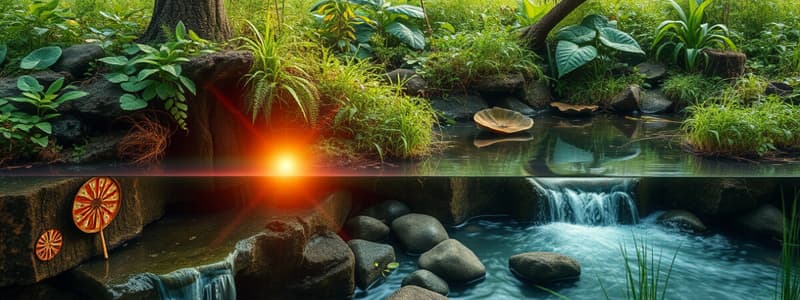Podcast
Questions and Answers
What role do autotrophs play in an ecosystem?
What role do autotrophs play in an ecosystem?
- They produce their own food using sunlight or chemical energy. (correct)
- They are at the top of the food chain with few natural enemies.
- They break down dead or decaying matter.
- They consume plants and other organisms for energy.
Which of the following is NOT considered a biotic factor in an ecosystem?
Which of the following is NOT considered a biotic factor in an ecosystem?
- Plants
- Animals
- Temperature (correct)
- Bacteria
What defines tertiary consumers in an ecosystem?
What defines tertiary consumers in an ecosystem?
- They are omnivores that eat both plants and animals.
- They break down dead matter and return nutrients to the soil.
- They are top predators with few or no natural enemies. (correct)
- They are herbivores that consume primary producers.
Which statement accurately describes primary consumers?
Which statement accurately describes primary consumers?
How do abiotic factors influence an ecosystem?
How do abiotic factors influence an ecosystem?
What is the primary role of producers in an ecosystem?
What is the primary role of producers in an ecosystem?
Which trophic level consists primarily of herbivores?
Which trophic level consists primarily of herbivores?
What percentage of energy is typically transferred from one trophic level to the next?
What percentage of energy is typically transferred from one trophic level to the next?
Which of the following statements about food webs is correct?
Which of the following statements about food webs is correct?
How do primary and secondary succession differ?
How do primary and secondary succession differ?
What is one impact of human-induced disturbances on ecosystems?
What is one impact of human-induced disturbances on ecosystems?
What is the main function of decomposers in an ecosystem?
What is the main function of decomposers in an ecosystem?
Which statement about energy pyramids is true?
Which statement about energy pyramids is true?
Natural disturbances can have what kind of effects on ecosystems?
Natural disturbances can have what kind of effects on ecosystems?
What role does the sun play in ecosystems?
What role does the sun play in ecosystems?
Flashcards are hidden until you start studying
Study Notes
Introduction to Ecosystems
- An ecosystem is a complex network of living organisms interacting with each other and their non-living environment.
- The size of ecosystems can range from small (pond) to vast (ocean), with various forms of complexity.
Components of an Ecosystem
-
Biotic Factors: Living components consisting of:
- Producers (Autotrophs): Convert sunlight/chemical energy into food (e.g., plants, algae).
- Consumers (Heterotrophs): Rely on other organisms for energy, categorized as:
- Primary Consumers: Herbivores like deer and rabbits.
- Secondary Consumers: Carnivores/omnivores such as wolves and humans.
- Tertiary Consumers: Top predators with few natural enemies like lions and sharks.
- Decomposers (Detritivores): Break down dead matter, recycling nutrients (e.g., fungi, bacteria).
-
Abiotic Factors: Non-living components influencing ecosystems, including:
- Temperature: Affects organism survival.
- Water: Essential for life; quality and availability are critical.
- Light: Influences plant growth.
- Soil: Type and quality dictate plant varieties.
- Air: Gas composition, especially oxygen and carbon dioxide, is vital for life processes.
Energy Flow in Ecosystems
-
Energy moves in a unidirectional flow from the sun to producers, then to consumers.
-
The Sun: Ultimate energy source; energy captured via photosynthesis by producers.
-
Trophic Levels:
- Primary Producers (Level 1): Convert solar energy into chemical energy.
- Primary Consumers (Level 2): Herbivores consuming producers.
- Secondary Consumers (Level 3): Carnivores/omnivores eating primary consumers.
- Tertiary Consumers (Level 4): Top predators that eat secondary consumers.
- Quaternary Consumers (Level 5): Apex predators at the food chain’s top.
-
Food Chains and Food Webs:
- Food Chain: Linear sequence illustrating energy flow (e.g., grass → rabbit → hawk).
- Food Web: Complex interconnected food chains representing actual feeding relationships.
-
Energy Transfer Efficiency:
- 10% Rule: Only about 10% of energy is transferred to the next trophic level; 90% lost as heat or used in metabolism.
- Energy Pyramid: Visually displays decreasing energy from base (producers) to apex (top predators).
Ecosystem Dynamics
-
Ecosystems are dynamic, influenced by internal and external factors causing fluctuations in populations and species diversity.
-
Succession:
- Primary Succession: Occurs in lifeless areas (e.g., after volcanic eruptions) led by pioneer species.
- Secondary Succession: Follows disturbances in existing ecosystems (e.g., after a forest fire), generally quicker due to existing soil and seeds.
-
Disturbances:
- Natural Disturbances: Events like wildfires and floods can have both destructive and beneficial effects.
- Human-Induced Disturbances: Activities like deforestation and pollution lead to habitat loss and altered energy flow.
-
Resilience and Stability:
- Resilience: Ecosystem’s ability to recover from disturbances.
- Stability: Ability to maintain structure and function over time, often supported by high biodiversity.
Energy Flow and Human Impact
-
Human activities disrupt natural energy flows, necessitating sustainable practices for ecosystem health.
-
Agriculture: Monocultures reduce biodiversity and decrease ecosystem resilience.
-
Fossil Fuel Use: Contributes to climate change, affecting temperature and weather patterns.
-
Pollution: Contaminants disrupt food chains and energy flow by accumulating in organisms.
-
Deforestation: Removes producers essential for capturing solar energy, resulting in habitat loss and climate changes.
-
Overfishing: Disrupts aquatic food webs and energy flow, threatening key species.
-
Conservation Efforts: Aimed at protecting habitats and promoting sustainable resource use, including protected areas and ecosystem restoration projects.
Conclusion
- Ecosystems consist of interdependent relationships among components, crucial for life sustenance.
- Human activities have led to a loss of biodiversity and altered energy flow, making understanding and addressing these impacts critical for ecological health.
Studying That Suits You
Use AI to generate personalized quizzes and flashcards to suit your learning preferences.




